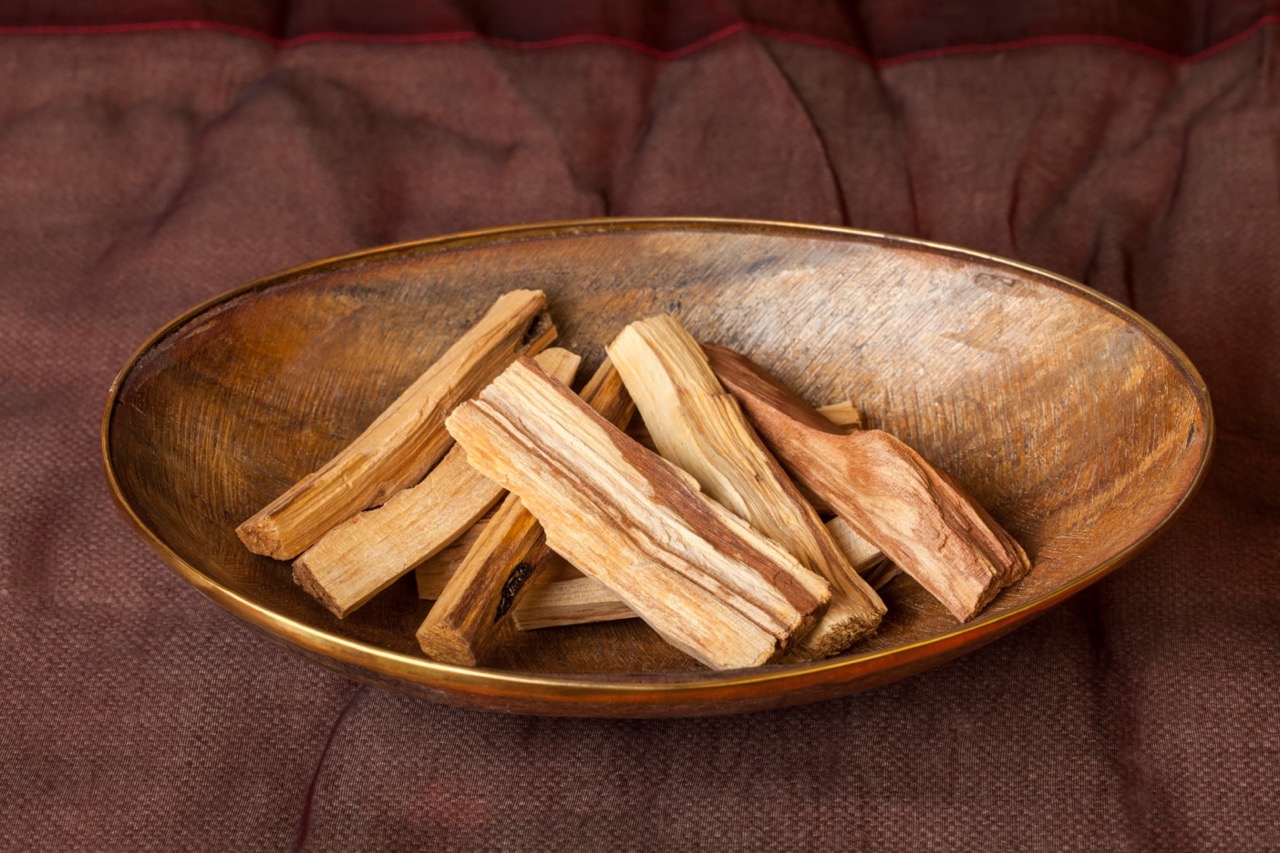
Palo Santo: a sacred wooden incense burner from Peru
In recent years, Palo Santo has become synonymous with space clearing and meditation rituals around the world. This sacred wooden product, which comes from South America, is popular not only for its pleasant aroma, but also for its medicinal properties. Surrounded by an aura of mysticism and ancient traditions, it is a source of healing, spiritual purity and harmony. But what exactly is Palo Santo and why has it gained such popularity?
THE VALUE OF PALO SANTO IN WELL-BEING
1. Breathing it is used to lift your mood, relieve stress and against asthma.
2. The scent of the stick serves as a 100% natural mosquito repellent, ideal for children's rooms.
3. It has antidepressant, diaphoretic, diuretic, purifying, anti-rheumatic, antiseptic, anti-fungal and other properties.
4. Helps to prevent influenza (element: Alpha-Pinene).
5. It fulfils an antiseptic function, destroying microbes to reduce the possibility of infections (element: Terminen-4-OL).
6. Antiviral (component: Sesquiterpene).
7. Its main component is Limonene (62.88%), which helps prevent tumours of the stomach, liver, breast and skin.
How to choose a quality Palo Santo?
Quality Palo Santo has a rich, sweet and clean aroma that develops as it burns. Avoid products that have a chemical or synthetic smell, which may indicate impurities or artificial treatments. Verified sources and transparency of the supply chain are criteria for choosing ethical and quality Palo Santo.

History and origin of Palo Santo
Palo Santo, or Bursera graveolens, is a sacred wood originating from Latin America, especially from the regions of Ecuador, Peru, Bolivia, Brazil and other parts of the Amazon rainforest. It prefers drier conditions and is often found in tropical forests where it is part of the local ecosystem. This wood has a rich historical and cultural value that goes back thousands of years, when native cultures used it for its healing and spiritual properties.
Native tribes such as the Incas and their predecessors believed that Palo Santo had magical properties, including the ability to cleanse a place or person of evil spirits, bad luck, and negative energy. This wood was used in various rituals and ceremonial activities, as part of healing ceremonies and meditation practices, where its aromatic smoke brought calm, harmony and spiritual purity.

Botanical description of Palo Santo
Bursera graveolens or Palo Santo, belonging to the Burseraceae family, is a medium-sized tree that can grow up to 20 meters tall. It has a characteristic smooth, papery bark that peels off naturally. Its leaves are green, shiny and release a pleasant aroma when rubbed or damaged. It blooms with small white or yellow flowers, which later turn into small fruits.
How Palo Santo is obtained?
Obtaining Palo Santo is a process that requires respect and understanding of nature. The Palo Santo wood from which the products are made comes from trees that die naturally and remain lying in the forest for at least 4 to 10 years. During this time, the wood ferments and develops its unique chemical composition and characteristic aroma.
This process ensures that wood harvesting is sustainable and does not harm the forest ecosystem. Sustainably sourcing Palo Santo also supports the conservation of these sacred trees and ensures they are available for future generations. Adherence to these principles is key to the ethical procurement and distribution of Palo Santo.
Using Palo Santo
The uses of Palo Santo are varied and diverse, including spiritual, therapeutic and aesthetic applications. Its most famous use is in purification and meditation rituals, where Palo Santo wood is lit and its smoke is used to remove negative energy and attract positive vibrations. This process is known as "smudging".
Using Palo Santo is both simple and ritualistic. Before starting to light the wood, it is important to set a positive intention. You light the wood and let it burn for a few seconds, then blow or wave to extinguish the flame, allowing the smoke to spread around the room. You can also use it during meditation or yoga practice to intensify your experiences and connection with the inner self.
In addition to spiritual use, Palo Santo is also used in aromatherapy due to its relaxing and calming effects. Its sweet, woody scent helps relieve stress, anxiety and promotes a sense of calm and well-being. Palo Santo is also used to prepare essential oils that are applied in massages and therapeutic procedures to relieve pain, inflammation and promote overall health.
On a practical level, Palo Santo can be used as a natural repellent against mosquitoes and other insects, making it a useful companion not only in the home, but also in outdoor activities. Its smoke has the ability to wash away negative energy and bring harmony and peace to the home.
- Space clearing: Light one end of the Palo Santo and let it burn for a while. Then run the smoke over the area you want to cleanse.
- Meditation and Relaxation: Place a lit Palo Santo in a safe, non-flammable holder and let its smoke and aroma fill the room, creating a calming atmosphere.
- Aromatherapy: You can also use Palo Santo in diffusers or as part of massage oils to improve well-being.

Potential benefits and scientific knowledge
Palo Santo is known for its potential therapeutic and healing properties. Traditions have used it since ancient times to relieve symptoms of inflammation, respiratory problems and to improve mood. Scientific studies are beginning to support these traditional uses, pointing to the content of compounds such as limonene and terpineol, which have antimicrobial, antiseptic and anti-inflammatory effects.
Recent research also suggests that Palo Santo can have a positive effect on mental health, helping to alleviate anxiety, depression and stress due to its ability to improve mood and have a relaxing effect.

Ethical and sustainable practices
Ensuring the ethical and sustainable sourcing of Palo Santo is key to protecting its natural environment and ensuring its availability for future generations. Adherence to strict guidelines for the collection of fallen branches and trees that die naturally reduces the negative impact on the forests. Certifications and programs like CITES (Convention on International Trade in Endangered Species of Wild Fauna and Flora) are important to verify sustainability and ethical trade.
How to choose a quality Palo Santo
Quality Palo Santo has a rich, sweet and clean aroma that develops as it burns. Avoid products that have a chemical or synthetic smell, which may indicate impurities or artificial treatments. Verified sources and transparency of the supply chain are criteria for choosing ethical and quality Palo Santo.
Frequently Asked Questions (FAQ)
Q: How often should I use Palo Santo?
A: It depends on personal preference and intended use. You can use Palo Santo as needed for space clearing or meditation.
Q: Is Palo Santo safe for pets?
A: In small quantities and with proper ventilation, Palo Santo should not cause problems. However, we recommend caution and stop using it at the first signs of restlessness in animals.
Q: Can Palo Santo be an allergen?
A: Although Palo Santo is generally well tolerated, individuals with fragrance sensitivities or allergies should exercise caution. It is recommended to start with a small amount and observe the reaction.
Q: How long does Palo Santo last?
A: If properly stored in a dry environment, Palo Santo can last for a very long time without losing its aroma or effects.
5 Most Prominent Studies on Palo Santo
(Bursera graveolens)
Based on a review of scientific sources (including PubMed, ResearchGate, and peer-reviewed journals), I’ve selected the five most significant studies on Palo Santo. These studies are chosen for their citation impact, relevance to pharmacological research, and alignment with traditional and modern uses (e.g., anticancer, antimicrobial, and anti-inflammatory properties). They focus primarily on the essential oil and lignans from the wood. Each study includes a brief description, key findings, and source.
- Chemical Composition and Anti-Proliferative Properties of Bursera graveolens Essential Oil Authors: Monzote L, Hill GM, Cuellar A, Scull R, Setzer WN (2012). Description and Findings: This study analyzes the chemical composition of Palo Santo essential oil (dominant component limonene, 26.5%) and its anticancer effects. The oil inhibits the growth of breast cancer cells (MCF-7) with an IC50 of 48.9 μg/mL and Leishmania amazonensis amastigotes with an IC50 of 36.7 μg/mL, showing promise as an antiproliferative agent. Impact: One of the most cited works on therapeutic properties. PubMed
- An Ethnopharmacological, Phytochemical and Pharmacological Review on Lignans from Mexican Bursera spp. Authors: Parra-Naranjo A, et al. (2018). Description and Findings: A comprehensive review of lignans from various Bursera species, including B. graveolens, focusing on ethnopharmacological, phytochemical, and pharmacological aspects. Lignans exhibit antioxidant, anticancer, anti-inflammatory, antimicrobial, and antiviral effects, traditionally used for pain, rheumatism, and skin conditions. Impact: Widely cited in subsequent research on Burseraceae. PMC
- A New and Known Cytotoxic Aryltetralin-Type Lignans from Stems of Bursera graveolens Authors: Nakanishi T, et al. (2005). Description and Findings: Isolation of a new lignan (burseranin) and the known picropolygamain from B. graveolens stems. Both show strong cytotoxic activity against human fibrosarcoma cells (HT1080), confirming potential as anticancer agents. Impact: An early key study on cytotoxic compounds, frequently cited in oncology research. PubMed
- Bioactive Principles and Biological Properties of Essential Oils of Burseraceae: A Review Authors: Tisserand R, Young R (2016). Description and Findings: A review of bioactive principles in essential oils from the Burseraceae family (including B. graveolens), emphasizing antidiabetic, antimicrobial, antioxidant, and anticancer properties. Palo Santo oil contains terpenes like limonene and α-terpineol, supporting traditional uses.Impact: A foundational review for further studies on essential oils. ResearchGate
- Biodegradation of Residues from the Palo Santo (Bursera graveolens) Essential Oil Extraction and Their Potential for Enzyme Production Using Native Xylaria Fungi from Southern Ecuador Authors: Carrión-Paladines V, et al. (2019). Description and Findings: This study explores the biodegradation of waste from essential oil extraction using Xylaria spp. fungi, with potential for enzyme production (lignase, cellulase). It supports sustainable uses of residues for biofuels and ethical resource management. Impact: Significant for environmental and industrial applications, cited in sustainability research. MDPI
These studies validate the traditional uses of Palo Santo in medicine (e.g., for inflammation, infections, and spiritual cleansing) while emphasizing the need for sustainable harvesting. If you need full texts or further details (e.g., on other aspects like phylogeography), let me know!
Conclusion
Palo Santo is more than just a nice smelling wood; it is an ancient practice that carries with it deep spiritual and healing traditions. At LaHerba.eu, we are proud to offer this sacred gift of nature, ensuring that it is sourced in a responsible and sustainable manner.
The Shawãdawa (Arara) tribe
‘Shawa’ means the red parrot Ara and ‘dawa’ means family. Around 1940 the tribe was thought to have died out. In the 1970s, the government tried hard to reach out to them because a highway was bein...
Mapacho: Sacred Tabaco and a Bridge to Spirit
Mapacho, also known as Nicotiana rustica, holds a deeply respected place in Amazonian traditions. Far more potent than the everyday tabaco found in cigarettes, Mapacho has been used for centuries b...
Chaga Siberian, Chaga - the strongest natural antioxidant in the world
Content of the article
1. What is chaga? What does this miracle mushroom bring?
2. What is chaga used for?
3. For what problems is it appropriate to reach for chaga?
4. What spectrum of vitamins does...
The Root Chakra (Muladhara): Your Key to Stability and Security
Do you often feel tired, anxious, or like your head is in the clouds, unable to focus? It might be time to tend to your foundations—your Root Chakra. This energy center is the pillar upon which y...






